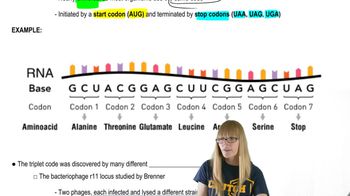Define genotype and phenotype. Describe how they are related and how alleles fit into your definitions.
Table of contents
- 1. Introduction to Genetics51m
- 2. Mendel's Laws of Inheritance3h 37m
- 3. Extensions to Mendelian Inheritance2h 41m
- 4. Genetic Mapping and Linkage2h 28m
- 5. Genetics of Bacteria and Viruses1h 21m
- 6. Chromosomal Variation1h 48m
- 7. DNA and Chromosome Structure56m
- 8. DNA Replication1h 10m
- 9. Mitosis and Meiosis1h 34m
- 10. Transcription1h 0m
- 11. Translation58m
- 12. Gene Regulation in Prokaryotes1h 19m
- 13. Gene Regulation in Eukaryotes44m
- 14. Genetic Control of Development44m
- 15. Genomes and Genomics1h 50m
- 16. Transposable Elements47m
- 17. Mutation, Repair, and Recombination1h 6m
- 18. Molecular Genetic Tools19m
- 19. Cancer Genetics29m
- 20. Quantitative Genetics1h 26m
- 21. Population Genetics50m
- 22. Evolutionary Genetics29m
1. Introduction to Genetics
Fundamentals of Genetics
Problem 7
Textbook Question
How is genetic information encoded in a DNA molecule?
 Verified step by step guidance
Verified step by step guidance1
Understand that genetic information in a DNA molecule is encoded by the sequence of nitrogenous bases along the DNA strand. These bases are adenine (A), thymine (T), cytosine (C), and guanine (G).
Recognize that the DNA molecule is composed of two complementary strands forming a double helix, where bases pair specifically: adenine pairs with thymine (A-T) and cytosine pairs with guanine (C-G).
Learn that the order or sequence of these bases along one strand constitutes the genetic code, which determines the instructions for building proteins.
Know that groups of three bases, called codons, correspond to specific amino acids or signals during protein synthesis, thus translating the genetic code into functional molecules.
Summarize that the genetic information is stored in the linear sequence of bases, and this sequence is what cells read and interpret to produce proteins, which carry out various functions in living organisms.
 Verified video answer for a similar problem:
Verified video answer for a similar problem:This video solution was recommended by our tutors as helpful for the problem above
Video duration:
1mPlay a video:
Was this helpful?
Key Concepts
Here are the essential concepts you must grasp in order to answer the question correctly.
Structure of DNA
DNA is composed of two strands forming a double helix, with each strand made up of nucleotides. Each nucleotide contains a sugar, a phosphate group, and one of four nitrogenous bases: adenine, thymine, cytosine, or guanine. The sequence of these bases encodes genetic information.
Recommended video:
Guided course

DNA Structure
Base Pairing Rules
In DNA, bases pair specifically: adenine pairs with thymine, and cytosine pairs with guanine. This complementary base pairing ensures accurate replication and transcription of genetic information, maintaining the integrity of the genetic code.
Recommended video:
Guided course

Base Distortions
Genetic Code and Information Encoding
The order of nitrogenous bases along the DNA strand forms the genetic code, which specifies the sequence of amino acids in proteins. Groups of three bases, called codons, correspond to specific amino acids, enabling the translation of genetic information into functional molecules.
Recommended video:
Guided course

The Genetic Code
Related Videos
Related Practice
Textbook Question
959
views


